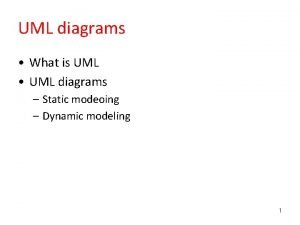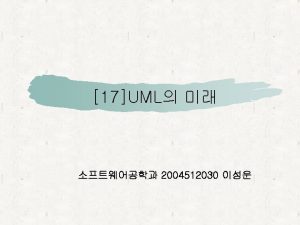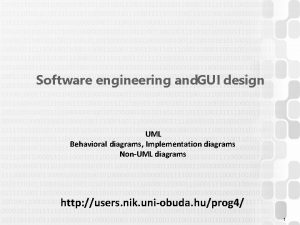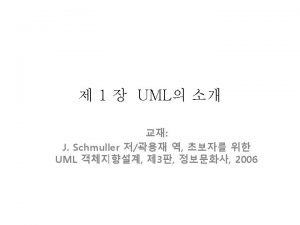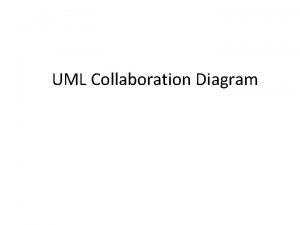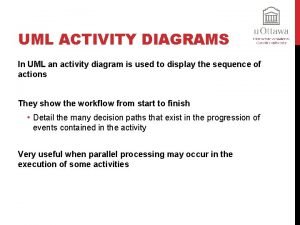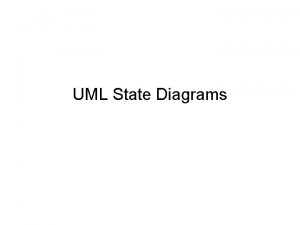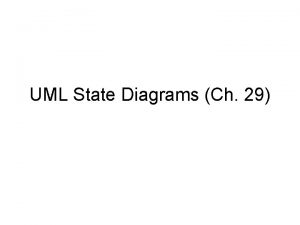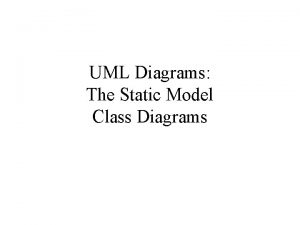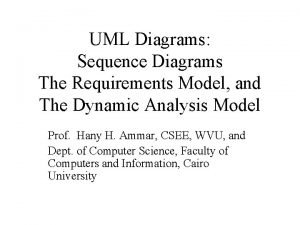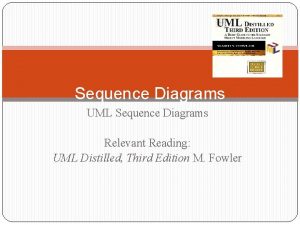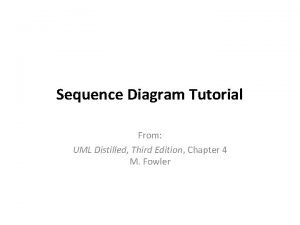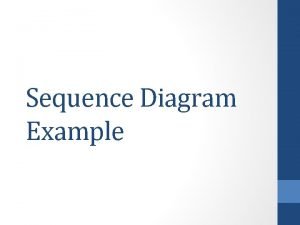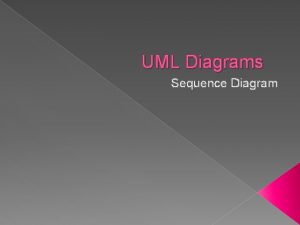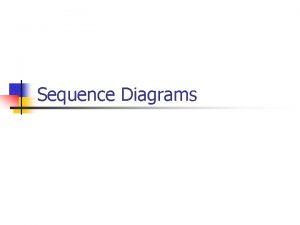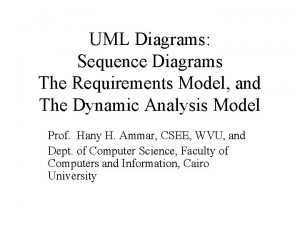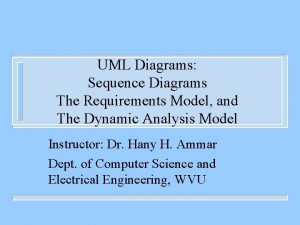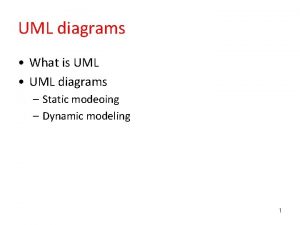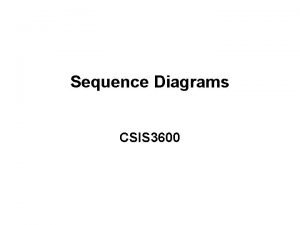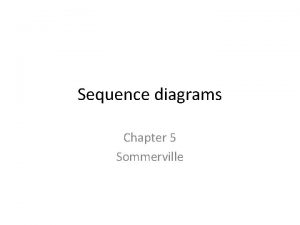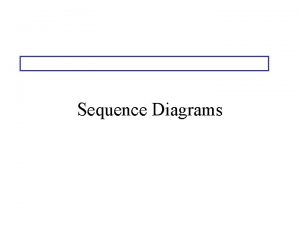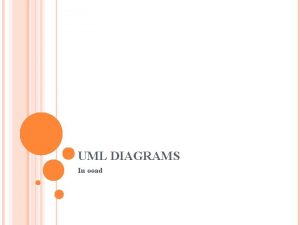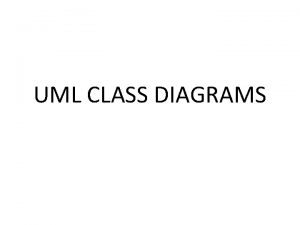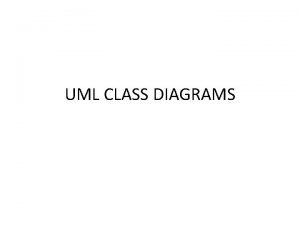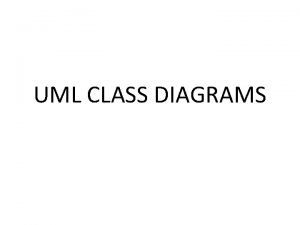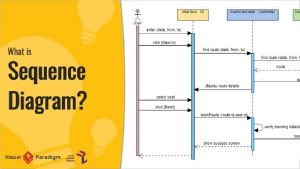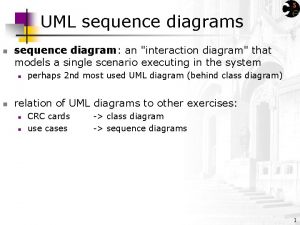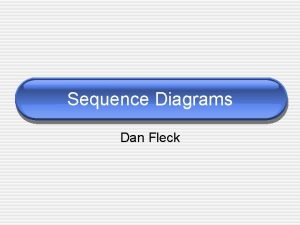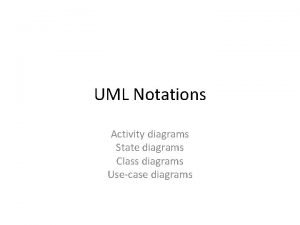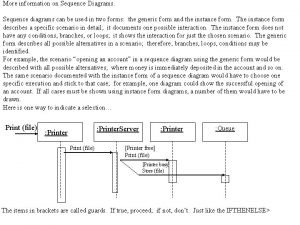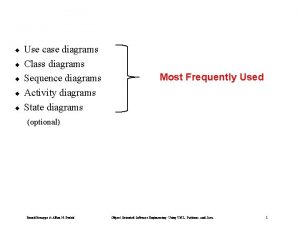UML Diagrams Sequence Diagrams The Requirements Model and

























- Slides: 25

UML Diagrams: Sequence Diagrams The Requirements Model, and The Dynamic Analysis Model Prof. Hany H. Ammar, CSEE, WVU, and Dept. of Computer Science, Faculty of Computers and Information, Cairo University

Outline • • The Requirements Model and the Analysis model Importance of Sequence Diagrams Rules of sequence diagrams Use Cases and Sequence Diagrams The System Sequence Diagrams The Vending Machine Example Other Examples

The Requirements Model and the Analysis Model The Requirements Elicitation Process Functional/ Nonfunctional Requirements Use Case Diagrams/ Sequence Diagrams (the system level) The Object-Oriented Static Analysis - Class Diagrams Analysis Dynamic Analysis - State Diagrams/ Process Refined Sequence Diagrams (The object level)

Importance of Sequence Diagrams • Depict object interactions in a given scenario identified for a given Use Case • Specify the messages passed between objects using horizontal arrows including messages to/from external actors • Time increases from Top to bottom

Rules of Sequence Diagrams • Sequence Initiation

Rules of Sequence Diagrams • Identify objects needed to support use case, determine sequence of internal events following the external initiating event • Diagrams that are not initiated with an external actor represent only a partial sequence • Partial sequence diagrams should clearly identify the actor initiated sequence diagrams from which they are launched

Rules of Sequence Diagrams • Messages specified on interactions can be synchronous or asynchronous Synchronous call

Rules of Sequence Diagrams Asynchronous call

Rules of Sequence Diagrams • Display operation names on call arrows

Rules of Sequence Diagrams Compound and Simple Iteration

‘included’ sequence diagrams

Showing alternate behavior in a sequence diagram

Showing Extension Point

Specifying Timing Requirements

Requirements Elicitation Process Step 4. Refining Use Cases using System Sequence Diagrams • System sequence diagrams establish the dynamic behavior in terms of key scenarios of the system for each use case • The system sequence diagram models a scenario of the system interactions with the environment for a given use case • Input/output events are clearly identified in each sequence diagram, • The State of the system before and after each event are also depicted • Different diagrams model scenarios with the normal flow of events and the abnormal flow of events

Sequence Diagrams and Use Cases System Sequence Diagram The use case diagram Of system S The sequence diagram of use case UC 1 for system S

Example: Use Case Diagram of the Vending Machine

Requirements Elicitation Process Step 6. Identify Initial Analysis Objects- The Initial Object-Model <<actor>> <<actor>> Designate the Actor objects with the <<actor>> stereotype above the object label

System Sequence Diagram for Deposit Money Use Case

System Sequence Diagram for Make Selection Use Case

System Sequence Diagram for Cancellation Use Case

System Sequence Diagram for Update Database Use Case

Other Examples of Sequence Diagrams

A Simple Example of Using UML 2 • EXAMPLE: SATELLITE CONTROL SYSTEM

A Simple Example Using UML 2 • SATELLITE CONTROL SYSTEM Architectural behavior
 Uml diagrams
Uml diagrams Context diagram of hospital management system
Context diagram of hospital management system What is class diagram
What is class diagram Interaction overview diagram
Interaction overview diagram Analysis class diagram
Analysis class diagram Behavioral diagrams in uml
Behavioral diagrams in uml Uml diagram wiki
Uml diagram wiki Uml collaboration diagram
Uml collaboration diagram Uml 2 activity diagram
Uml 2 activity diagram Fitness center use case diagram for gym management system
Fitness center use case diagram for gym management system Pos uml diagrams
Pos uml diagrams State diagrams uml
State diagrams uml Pos uml diagrams
Pos uml diagrams Michael quatrani
Michael quatrani In uml
In uml What is a physical element that exists at runtime in uml?
What is a physical element that exists at runtime in uml? Requirements engineering uml
Requirements engineering uml Use case model
Use case model Activity diagram if
Activity diagram if Sequence diagram alternative
Sequence diagram alternative Sequence diagram rules
Sequence diagram rules Sequence diagram interface
Sequence diagram interface System sequence diagram example
System sequence diagram example Uml sequence diagram tutorial
Uml sequence diagram tutorial Uml sequence diagram return value
Uml sequence diagram return value Difference between finite sequence and infinite sequence
Difference between finite sequence and infinite sequence


